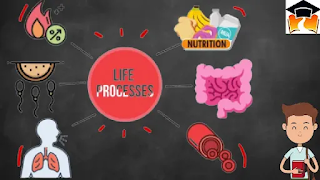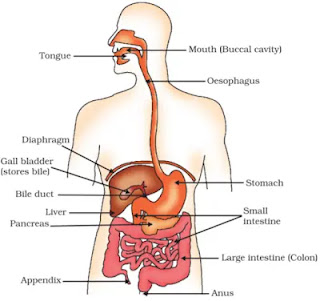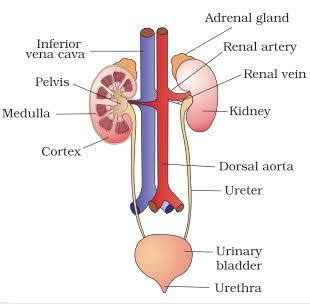Here I am going to provide you CBSE Class 10 Science Chapter 6 Life Processes Notes. By going through Life Processes Class 10 Notes you can revise the Life Processes chapter in a very effective way. I hope that this will certainly help you in your studies!
Introduction
- Earth happens to be the only known planet having a life.
- There are beings who live, die and become part of nature again.
- The living organism can be differentiated from the inanimate entities on various parameters of life processes
What Are Life Processes?
- The processes which together perform the function of maintenance of ‘life’ are called as life processes.
- Maintenance of living organism is essential even if they are moving, resting or even sleeping.
- Nutrition, respiration, circulation, excretion are examples of essential life processes.
- In unicellular organisms, all these processes are carried out by that single cell.
- In multicellular organisms, well-developed systems are present to carry out the processes.
Nutrition
The process of acquiring food that is needed for nourishment and sustenance of the organism is called nutrition.
How do living things get their food?
- The general requirement for energy and materials is common in all organisms, but it is fulfilled in different ways.
- There are two main modes of nutrition, autotrophic and heterotrophic.
Autotrophic Nutrition
- If an organism can nourish itself by making its own food using sunlight or chemicals such mode of nutrition is called as autotrophic nutrition.
- The organisms which carry out autotrophic nutrition are called autotrophs (green plants).
- Autotrophs use simple inorganic material and convert it into complex high energy molecules (Carbohydrates)
- Autotrophic nutrition is fulfilled by the process by which autotrophs take in CO2 and H2O and convert these into carbohydrates in the presence of chlorophyll, sunlight is called Photosynthesis.
| Equation for Photosynthesis |
- Chlorophyll present in the green parts absorbs light energy.
- This light energy is used to split water into hydrogen and oxygen.
- Hydrogen is then used to reduce carbon dioxide into carbohydrates, typically glucose.
- Chlorophyll is essential for photosynthesis and stomata to facilitate intake of carbon dioxide.
Stomata
- Stomata are pores on the leaves that help in exchange of gases.
- They are mostly found on the underside of the leaf.
- Each stoma is guarded by guard cells, which control the opening and closing of the pore.
- The water content of the guard cells is responsible for their function.
Heterotrophic Nutrition
- Kind of nutrition in which organisms do not possess the ability to synthesize their own food. They depend on autotrophs for their food supply directly or indirectly.Example: Animals, fungi.
- Holozoic Nutrition: Animals take in solid food and breakdown inside the body.Example: Amoeba, animals.
- Saprophytic Nutrition: Organisms feed on dead, decaying matter.Example: Fungi.
- Parasitic Nutrition: Parasites live inside or outside other organism (host) and derive nutrition from it.Example: Cuscuta (plant parasites), Ticks etc.
Nutrition in Amoeba
- Amoeba feeds by holozoic mode of nutrition.
- It engulfs the food particle using pseudopodia, the process is called phagocytosis.
- The engulfed food gets enclosed in a food vacuole.
- As the food vacuole passes through the cytoplasm, digestion, absorption and assimilation take place.
- When the food vacuole opens to outside, egestion of undigested food takes place.
- Paramoecium also exhibits holozoic nutrition.
- However, they have cilia that help them to engulf the food through the oral groove.
- A food vacuole is created enclosing the food.
- It moves through the cytoplasm, the process is called cyclosis.
- Food digested in the food vacuole is absorbed by the cytoplasm.
- Undigested food is given out to a tiny pore called anal pore or cytopyge.
Nutrition in Human Beings
- Humans are omnivores, they can eat plant-based food as well as animal-based food.
- Being more complex, humans have a very complicated nutrition system.
- The digestive system has an alimentary canal and associated digestive glands, which together function to nourish the body.
- There are five stages in human nutrition; Ingestion, Digestion, Absorption, Assimilation and Egestion.
- Four stages i.e. ingestion, digestion, absorption and egestion take place in the alimentary canal while assimilation of food takes place in the whole body.
Mouth: Intake of whole food.
Teeth: Chewing/grinding of food.
Salivary Glands: Secrete saliva + Mucus (It is a sticky, gelatinous material that lines your lungs, throat, mouth, nose, and sinuses.) + Starch is converted into glucose by saliva (Salivary amylase)
Stomach: Gastric glands present in stomach secrete gastric juice.
Small Intestine: The small intestine is the site of the complete digestion of carbohydrates, proteins and fats.
- Walls of small intestine secrete intestinal enzyme which convert Carbohydrates into glucose, fats in fatty acid + glycerol and Proteins into amino acids.
- It has Villi (finger like projection) which help in the absorption of food into blood.
- It receives the secretions of the liver and pancreas.
- The food is acidic which is made alkaline for the pancreatic enzymes to act. The pancreas secretes pancreatic juice which contains enzymes like trypsin for digesting proteins and lipase for breaking down emulsified fats.
- Fats are present in the intestine in the form of large globules which makes it difficult for enzymes to act on them. Bile salts break them down into smaller globules which increases the efficiency of enzyme action.
- It absorbs excess of water.
- The rest of the material is removed from the body via the anus.
Respiration
- Respiration broadly means the exchange of gases.
- Animals and plants have different means of exchange of gases.
- At a cellular level, respiration means the burning of the food at the for generating the energy needed for other life processes.
- Cellular respiration may take place in the presence or absence of oxygen.
Respiration in Human Beings
(i) Gaseous exchange (Breathing) : Intake of oxygen from the atmosphere and release of CO2.
Breakdown of Glucose by Various Pathways:
- The first step is the break-down of glucose (a six-carbon molecule) into a three-carbon molecule called pyruvate which takes place in the cytoplasm.
- The pyruvate may be converted into ethanol and carbon dioxide which takes place in yeast during fermentation. Since this process takes place in the absence of air (oxygen), it is called anaerobic respiration.
- The pyruvate is broken down into three-carbon pyruvate molecule in the presence of oxygen to give three molecules of carbon dioxide and water. This process takes place in mitochondria. Since this process takes place in the presence of air (oxygen), it is called aerobic respiration.
- The pyruvate is converted into lactic acid when there is a lack of oxygen in our muscle cells, which is also a three-carbon molecule. This build-up of lactic acid in our muscles during sudden activity causes cramps.
- The energy released during cellular respiration is immediately used to synthesise a molecule called ATP which is used to fuel all other activities in the cell. In these processes, ATP is broken down giving rise to a fixed amount of energy which can drive the endothermic reactions taking place in the cell.
- The rate of breathing in aquatic organisms is much faster than that seen in terrestrial organisms because the amount of dissolved oxygen is fairly low compared to the amount of oxygen in the air.
Types of Respiration
Human Respiratory System
- Nostril: Air is taken into the body.
- Nasal Passage: It is a channel for airflow through the nose.
- Nasal Cavity: It is lined with hairs and mucus membrane. It warms, moisturize, and filter air before it reaches the lungs.
- Pharynx: It contains rings of cartilage which ensure that the air-passage does not collapse.
- Larynx: It houses the vocal cords and manipulates pitch and volume, which is essential for phonation. It is also known as voice box.
- Trachea: Pharynx splits into trachea and esophagus. It connects the larynx (or voice box) to the bronchi of the lungs. It provides air flow to and from the lungs for respiration.
- Bronchi: They are the main passageway into the lungs. They are the extensions of the windpipe that shuttle air to and from the lungs. The oxygen goes to the lungs and carbon dioxide leave the lungs through them.
- Bronchioles: Bronchi get smaller when they reaches closer to lungs tissues and are called Bronchioles. They are the passageways by which air passes through the nose or mouth to the alveoli of the lungs
- Alveoli: They are smaller tubes which finally terminate in balloon-like structures which are called alveoli. They allow oxygen and carbon dioxide to move between the lungs and bloodstream.
- Blood capillaries: They are the sites of the transfer of oxygen and other nutrients from the bloodstream to other tissues in the body. They also collect carbon dioxide and waste materials and return it to the veins.
(i) Air (rich in O2) reaches blood which combines with haemoglobin in RBC and O2 is released in alveoli tissues (through blood vessels).
- Terrestial organisms: Use atmospheric oxygen for respiration.
- Aquatic organisms: Use dissolved oxygen for respiration.
Respiration in plants
Transportation
- All living organisms need a few necessary components like air, water, and food for their survival.
- On our regular basis, animals ensure these elements by breathing, drinking and eating.
- The required elements are transported to their body cells and tissues by a transportation system.
- In plants, the vascular tissue is responsible for transporting the substances.
Transportation in Humans
- Transportation in humans is done by the circulatory system.
- The circulatory system in humans mainly consists of blood, blood vessels and heart.
- It is responsible for the supply of oxygen, nutrients, removal of carbon dioxide and other excretory products.
- It also helps to fight the infections.
(i) Heart (pumping organ)
(ii) Arteries and Veins (Blood vessels)
(iii) Blood and lymph (Circulatory medium)
- The lungs supply oxygen-rich blood to the the left atrium of the heart.
- The left atrium relaxes when it is collecting the blood and contracts when blood is transferred to the left ventricle. The left ventricle expands when it receives blood.
- The blood is pumped out of the body when the muscles of left ventricle contracts.
- De-oxygenated blood comes from the body to the upper chamber on the right i.e. the right atrium when it expands.
- The corresponding lower chamber i.e. the right ventricle expands when right atrium contracts. It transfers the blood to the right ventricle which in turn pumps it to the lungs for oxygenation.
- Right ventricles have thicker muscular walls so that they pump blood into various organs.
- Valves ensure that blood does not flow backwards when the atria or ventricles contract.
- Double circulation: Blood travels twice through the heart in one complete cycle of the body.
- Pulmonary Circulation: Blood moves from the heart to the lungs and back to the heart.
- Systemic Circulation: Blood moves from the heart to rest of the body and back to the heart.
Blood
- Blood is connective tissue which is fluid in nature.
- Solid components of blood (Blood corpuscles):
- RBC (Red blood cells): It carries O2 and CO2 and also contain Haemoglobin which impart red colour to the blood.
- WBC (White blood cells): It provides body defence by engulfing the germs and produces antibodies.
- Blood Platelets: It helps in blood clotting during injury.
- Liquid components (Plasma): It is a yellow colour fluid which contain 90% water & 10% organic substances.
Lymph
- It is a yellowish fluid which escapes from the blood capillaries into the intercellular spaces.
- It contains less proteins than blood.
- It flows from the tissues to the heart which helps in transportation and destroying germs.
- It carries digested and absorbed fat from intestine and drains excess fluid from extra cellular space back into the blood.
Types of Blood Vessels
Transportation in Plants
There are two main conducting pathways in a plant.
(i) Xylem
(ii) Phloem
Transpiration and its Functions
Function :
Transport of food from leaves (food factory) to different part of the plant is called Translocation.
Excretion
- The metabolic activities in the body generates many kinds of wastes including nitrogenous wastes which are harmful for the body and hence needed to be removed. Excretion is a process by which these wastes are removed from our body.
- Unicellular organisms remove these wastes by simple diffusion.
Excretion in Human Beings
Excretory/urinary system consists of :
- The kidneys : The excretory organ
- The ureters : The ducts which drain out urine from the kidneys
- The urinary bladder : The urinary reservoir
- The urethra : The channel to the exterior
- Each kidney contains many filtration units called as nephrons.
- Nephrons are made up of a cluster of thin walled capillaries called glomerulus which is associated with a cup like structure called as Bowman’s capsule and the long tube which terminates through this capsule.
 |
| Structure of Nephron |
- The renal artery brings oxygenated blood to the kidneys along with the nitrogenous wastes like urea and uric acid and many other substances.
- The blood gets filtered through the glomerulus and this filtrate enters the tubular part of nephron.
- As this filtrate moves down the tubular part, glucose, amino acids, salts and excess of water gets selectively reabsorbed by the blood vessels surrounding these tubules.
- The amount of water reabsorbed depends upon :
- How much excess of water is there in the body and,
- How much nitrogenous wastes need to be excreted out.
- So the fluid now flowing in the tubular part is urine which gets collected in collecting ducts of nephrons.
- These collecting ducts together leave the kidney at a common point by forming the ureter.
- Each ureter drains the urine in the urinary bladder where it is stored until the pressure of expanded bladder leads to an urge to pass it out through urethra.
- This bladder is a muscular structure which is under nervous control.
- 180 litres of filtrate is formed daily but only 2 litres is excreted out as urine so the rest is reabsorbed in the body.
Haemodialysis: The process of purifying blood by an artificial kidney. It is meant for kidney failure patients.
Excretion in Plants
Plants use different strategies for excretion of different products :
- Oxygen and carbon dioxide is diffused through stomata.
- Excess water is removed by transpiration.
- Plants can even loose some of their old parts like old leaves and bark of tree.
- Other waste products like raisins and gums especially in old xylem cells which can also be lost by plants.
- Plants also secrete some waste substances into the soil around them
More resources for class 10:
Chapterwise NCERT Solutions For Class 10 Science
CBSE Class 10 Science Chapterwise Notes
Chapterwise NCERT Solutions For Class 10 Social Science
CBSE Class 10 Social Science Chapterwise Notes
Chapterwise NCERT Solutions For Class 10 Sanskrit
CBSE Class 10 Sanskrit Chapterwise Summary











.webp)

